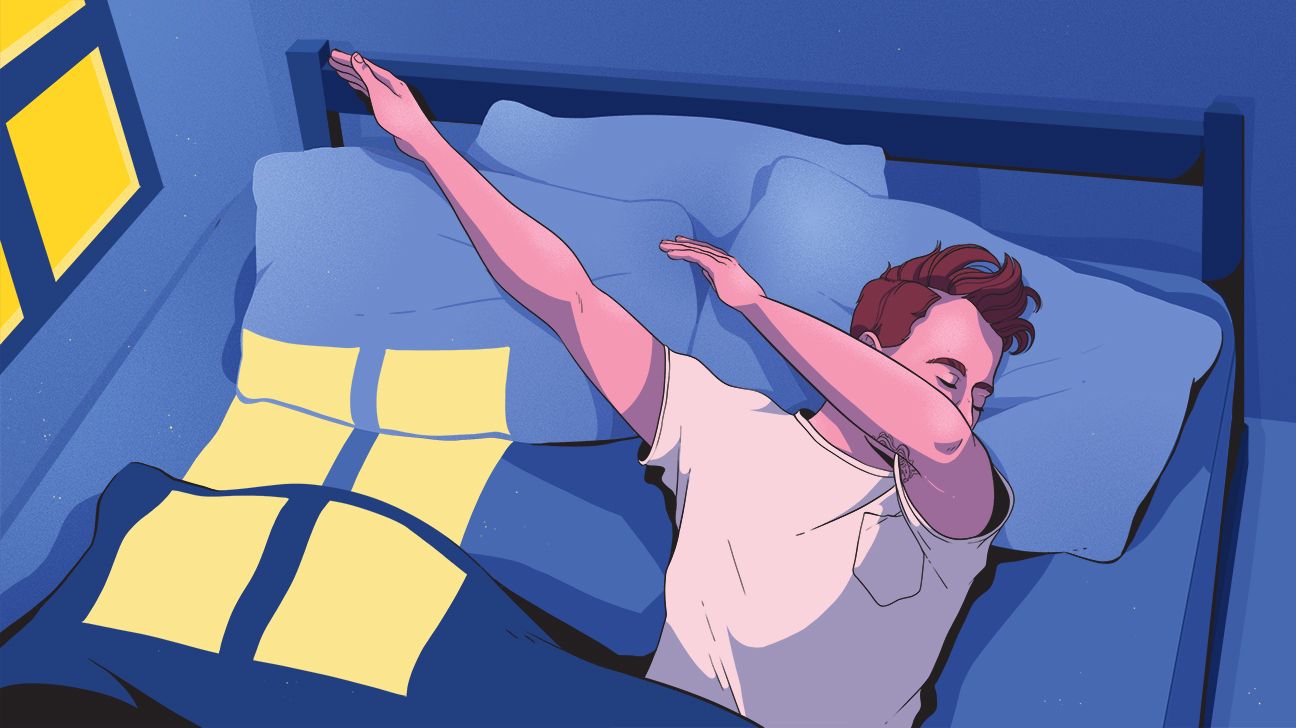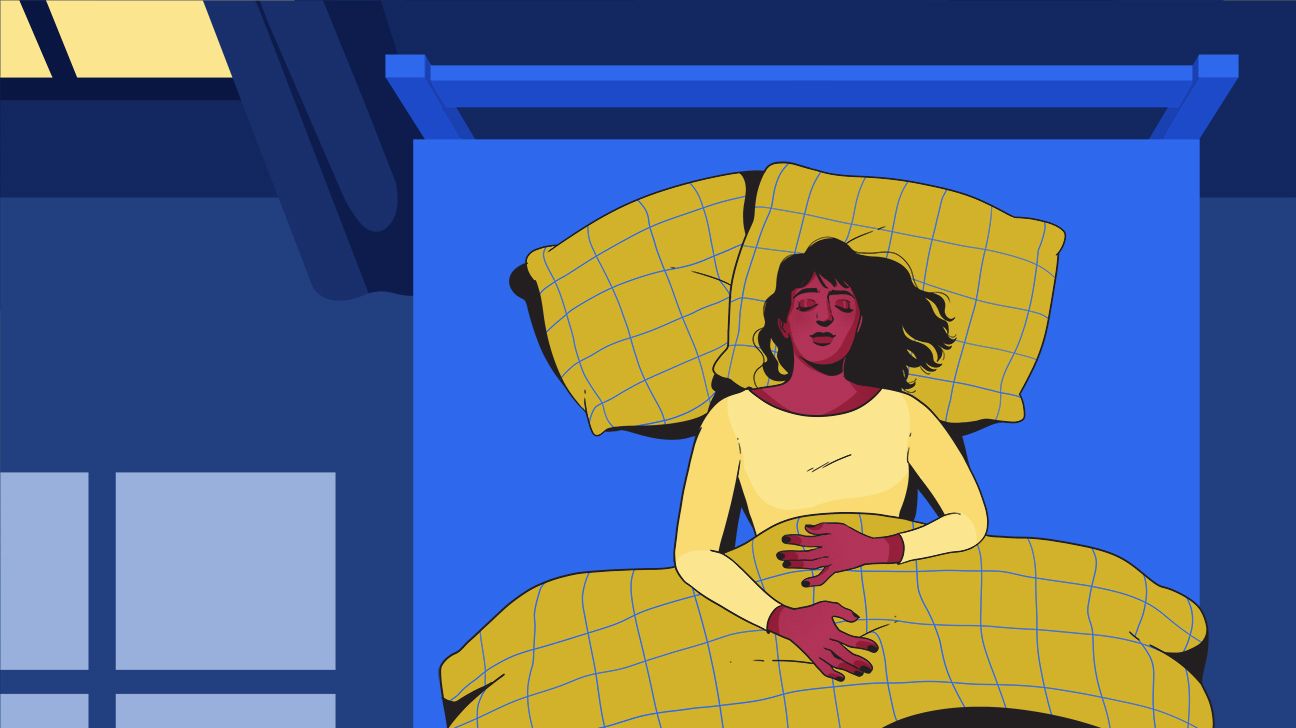We include products we think are useful for our readers. If you buy through links on this page, we may earn a small commission. Here’s our process.
Greatist only shows you brands and products that we stand behind.
Our team thoroughly researches and evaluates the recommendations we make on our site. To establish that the product manufacturers addressed safety and efficacy standards, we:- Evaluate ingredients and composition: Do they have the potential to cause harm?
- Fact-check all health claims: Do they align with the current body of scientific evidence?
- Assess the brand: Does it operate with integrity and adhere to industry best practices?
The best sleeping position is what’s comfortable for you. However, the shape your body makes when you’re asleep can affect different parts of your body. For something so simple even babies do it, sleep isn’t such an easy thing to master. In fairness, they do have a lot more time to work on it.
Both too little and too much time dozing has been linked to a host of health problems, from obesity and heart disease to dementia and diabetes. It also turns out that it’s not just the length of sleep that matters — it’s also the position you’re in.
(It’s not the length of the longboat, it’s the position of the splishin’.)
The way you sleep can play a big role in snoring, heartburn, and even wrinkles. Read on to see if you should switch it up in bed (remember, we’re talking sleep here). We looked at the research on sleeping positions and how they affect your back and general health.
Unfortunately, high-quality studies on this field are rare due to tiny sample sizes. Sleep positions have, quite literally, been slept on. We have, however, been able to develop a general picture of the pros and cons of each.
Sleeping on your back, or “supine position,” is great for your back itself, but can screw with your breathing.
Pros of back sleeping
Snoozing in Savasana pose is a boon for spine and neck health. The back stays straight and untwisted, which is just swell. Plus, back sleeping helps the mattress do its job of supporting the spine.
In a perfect (and slightly uncomfy) world, everyone would sleep on their backs without a pillow. This position leaves the neck in a neutral position. Using too many pillows, however, can make breathing more difficult.
Back sleeping is also a winner for the more cosmetically inclined. Spending all night with your face out in the air and not smooshed up against a pillow can lead to fewer facial wrinkles.
If you’re looking to reduce wrinkles without spending money on products, look no further.
Cons
Snoring and sleep apnea become much more frequent when a person is sleeping in the supine position. In fact, back sleeping is so closely linked to sleep apnea that doctors prescribe side sleeping as a treatment for the condition.
When you sleep on your back, gravity forces the base of the tongue to sink into the airway. This obstructs breathing and creates those oh-so-pleasant snoring noises that keep the neighbors up at night.
It’s also worth noting that a supported spine doesn’t always necessarily mean a good night’s sleep.
An earlier study compared the sleep habits of good sleepers and poor sleepers. The authors noted the people with worse-quality sleep spent more time on their backs than the good sleepers.
However, as hair has moved on (a great deal) since the 80s, so too has science. So take this with a pinch of salt — ultimately, if you’re comfortable, you’ll sleep well.
A 2017 study found that most people prefer sleeping on their side.
Attaboy, side-sleeping!
Pros
Whether they’re curling up in the cozy fetal position or lying straight on one side, the vast majority of people report sleeping on their sides.
(Although, since everyone is unconscious during sleep, this information can never be entirely accurate.
Cons
Sleeping on the left side can put pressure on the stomach and lungs (alternating sides often can help prevent organ strain). And as almost all side-sleepers know well, this position can result in the dreaded squished-arm-numbness.
(That immortal dilemma of how to tactfully stop spooning your partner and roll onto your back to sleep comes into play here. If you do enjoy cuddling and have a penis, here’s how to do it without getting a boner.)
Resting the head (or the whole body) on a single arm can restrict blood flow and press down on the nerves, which results in “rubber arm” or painful pins and needles. You don’t want to wake up like a wacky waving arms inflatable tube man.
In this position, the shoulder supports a lot of the body’s weight, which can constrict the neck and shoulder muscles.
Then you’re looking at ouchies in the shoulders when you wake up. If they do hurt, try these 16 stretches for shoulder pain.
If you sleep with your belly down, things might go a bit belly-up.
Pros
As sleeping on your back can lead to increased snoring in some people, some sleep specialists recommend switching up your position to either side or front sleeping.
So, yes, stomach sleeping might ease snoring, but there’s no solid evidence that supports stomach sleeping over side sleeping. Breathe easy, bellies of the world. You shall remain unsquished, for now.
And, to be honest, even if those claims were backed by our science pals, they’re still pretty much the only good thing about going belly-down at night.
Cons
Resting on the tummy is pretty much the Limp Bizkit of sleep positions — a guilty pleasure when you can’t be bothered to find anything better, but ultimately not great for you in the long run.
So if you wind up dozing off while you’re face down, keep rollin’, rollin’, rollin’ until you’re on your side.
Stomach sleeping flattens the natural curve of the spine and pushes your body weight into your core, which can lead to lower back pain. Sleeping all night with your head turned to one side also strains the neck. Imagine watching an 8-hour tennis rally.
If you genuinely prefer this position, try gradually tilting your pillows to get your body comfortable with side-sleeping.
Worse still, putting your baby to sleep on their stomach can increase the risk of sudden infant death syndrome (SIDS).
If you’re feeling lower back twinges from changing your position, try sticking a pillow under the hips and lower abdomen to give the bottom of the spine a boost.
Pillow getting tired too? Here’s how to work out when it’s time for a new one.
Arguably the OG sleeping position, curling up in fetal position may not be a natural first port of call for many people in the quest for catching Zzz’s. Pulling your knees up to your chest isn’t really the go-to decision before sleeping (outside of the womb).
However, this position causes less bending at the bottom of your spine while you sleep. As a result, it can provide relief for people with a herniated disk.
Roll onto your left or right side, carefully place your pillow under your head and neck, and bring your knees into your chest until your back is straight. It’s no cure-all for a very painful back condition, but it can help you get your 40 winks with less disruption.
We found some stretches you can do to make your back feel better while you’re awake.
Sleeping positions aren’t only important for your own health — if you’ve got a tiny human inside you, you’ll also have to bear theirs in mind.
Naturally, the belly is a sensitive spot, and sleeping on both your right side or your back may increase the risk of a stillbirth (although, according to a 2019 study, it doesn’t increase the risk of complications as much as researchers originally thought.)
It’s better to be safe than sorry, though. If you’re not naturally a left side sleeper, don’t worry — pregnancy pillows and sleep aids can help you and your little trooper be more comfortable.
Side sleeping is also a winner during pregnancy as it relieves pressure on the lower back (which can lead to fainting). For obvious reasons, stomach-sleeping is also impossible while a person is pregnant.
People who side sleep can keep their spine aligned by placing a pillow between the knees.
For those expecting heartburn and acid reflux rather than a bouncing bundle of joy, sleeping on the left side may also ease heartburn and acid reflux, making it easier for people with these conditions to doze off.
While testing a new sleep reposition device, for example, researchers found that people sleeping on their left side experienced less exposure to acid in their esophagus — a sign that acid reflux posed less of a problem.
For a bit more relief during pregnancy, why not give yoga a try?
Regardless of health benefits, people sleep in the position they find the most comfortable.
Even if you start out in the ideal position, you’ll likely transition to a different one via the air guitar pose you striking during your dream solo in front of a packed-out Super Bowl.
But experimenting with different sleep positions won’t do any harm, so feel free to try each position for a few nights and see which is the best fit.Whether it’s back, side, or stomach, people tend to wake up in the position that their bodies naturally snooze in.
Unless a doctor specifically recommends switching, it’s probably best to keep doing what feels right. Sleep tight!
If you’re one of the many people who find it difficult to do so, we’ve got 31 ideas to help you sleep better.



